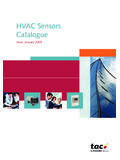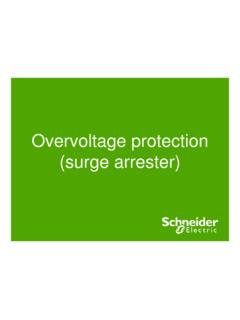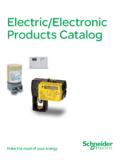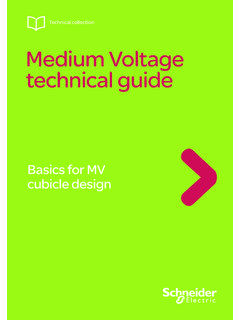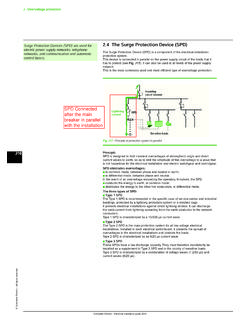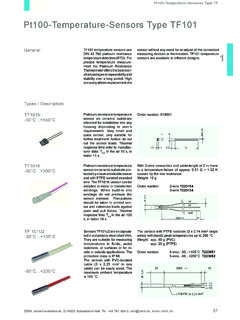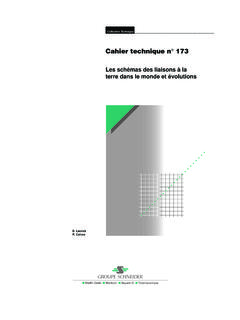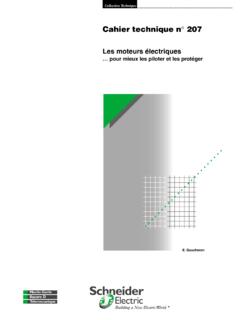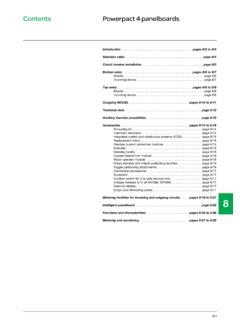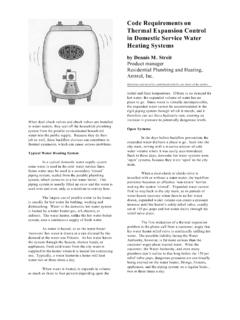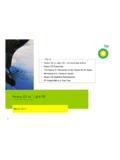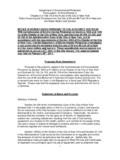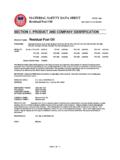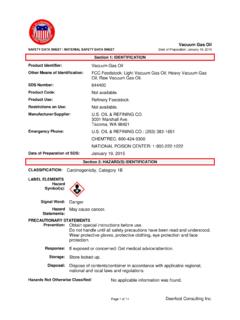Transcription of How to reduce damage to components through …
1 Control Panel Technical GuideHow to reduce damage to components through effective thermal management2To find out moreabout thermal management solutions for control enclosures, please consult our catalogue or visit our website at 3 ContentsIntroduction 4 to 71 Analysis of thermal conditions 8 to 13 Internal analyses External analyses2 thermal optimisation solutions Overview 14 to 15 "Passive" solutions 16 to 26 "Active" solutions 27 to 553 Practical summary 58 to 614 Guide for choosing thermal optimisation solutions 62 to 694 All the expertise of Schneider Electric devoted to the thermal management of your enclosuresMany of our customers, including design and engineering departments, panel builders, integrators or even OEMs, ask us to help them optimise the performance of their electrical installations, while complying with environmental constraints and avoiding thermal Electric, as a leading international specialist in energy-efficiency management , has drawn up this expert's operating guide for these customers (and any others).
2 through this overall fully practical and comprehensive document, Schneider Electric wants to share all its experience in thermal management of electric enclosures with its the expertise of Schneider Electric devoted to the thermal management of your enclosuresConsequencesEven the slightest shut-down or malfunction of the electrical installation can have major even catastrophic financial repercussions for a company, regardless of its business are some examples of business sectors in which 1 hour of down time can be very expensive:Motor industry 10,000 Agri-business industry 6,000 Microprocessor industry 35,600,000 Banking transaction services 2,940,000 Airline ticket-booking services 90,000 Mobile telephone operators 47,000 SMEs 350 Reasons why installations shut down or malfunctionIn the vast majority of cases, when electric installations and devices housed in control enclosures shut down or malfunction, the problem is thermal : excessively high or low temperature of electrical and, especially, electronic external climatic conditionsInternal heat balance not calculated Pollution and difficult or harsh environmental conditionsHigh likelihood of a breakdown or malfunction of the installationNB.
3 : Total financial losses depend on the size of the affected manufacturing (foundry) 50,000 Glassworks 40,0006 thermal management issues inside and outside your enclosuresAvoiding down-time and malfunctions caused by overheating of electrical and electronic devicesExtending the service life of the internal components Reducing costs associated with the manufacturing processes maintenance cycles and costs for the installation Guaranteeing continuity of service7 Reducing costs associated with the manufacturing processes maintenance cycles and costs for the installation Guaranteeing continuity of serviceThe ideal combination for an installation, with no breakdown riskChoose the right IP(according to the harshness of the environment)Choose the right thermal solution And correct installationKnowledge of losses of power in the installation (in W)Installation with no breakdown risk and suitable protection18 Analysis of thermal conditionsControl Panel - Technical Guide How to reduce damage to components through effective thermal management9 Analysis of thermal conditionsInternal analyses Analysis of thermal conditions inside the enclosureIt is essential to calculate a complete, reliable heat balance before considering any management solutions.
4 A heat balance consists of measuring and analysing thermal conditions inside And outside the enclosure. Based on these measurements, the ProClima software will help you identify the solutions that best suit your control enclosure and the environment in which it is onYour heat balance with ProClima softwareHow does it work? Nothing could be easier! Simply enter the collected thermal data in the software. ProClima will then suggest the solutions that best suit the features of your installation. And only these solutions!External analyses Analysis of weather conditions Analysis of pollution and difficult or harsh environmental conditions10 Control Panel - Technical Guide How to reduce damage to components through effective thermal managementThermal analysis inside the enclosureFirst of all, it is essential to identify the most delicate devices or functions: the ones that should be given protection devices can be the cause of shut-downs or malfunctions of the to know Critical temperature for each device Critical humidity level for each device> Electronic equipment is the most delicate> Ideal internal temp.
5 = Critical temp. of the most delicate device> High critical temp. of the variable speed drives: 50 Expert's tip The thermal management solution must be sized according to the critical temperature of the most delicate element of the enclosure. This temperature should never be exceeded. The mean working temperature recommended for the inside of the enclosure is 35 C. This is the reference temperature for the control equipment integrated in the thermal operating temperatureMaximum temperature with the risk of malfunctionVariable speed drives35 C50 CProgrammable logic controller35 C40 - 45 CContactors45 C50 CCircuit breakers45 C50 CFuses50 C50 CPower supply35 C40 CPrinted Circuit Board (PCBs)30 C40 CElectric batteries (accumulators)20 - 25 C30 CTelecommunications equipment40 - 50 C55 CPFC capacitors50 C55 CExample 1:The concentration of variable speed drives can push the inner temperature up to 70 C or higher (with no thermal solution installed).
6 Example 2:Batteries are highly sensitive to temperature should not exceed 25-30 study: Cranes with electro-magnetic lifting systems for handlingBatteries: 10 years lifetime11 Analysis of thermal conditionsThermal analysis inside the enclosureMeasuring the air temperature1 Measuring losses of power (W)2 The measurement of air temperature inside the enclosure, must be taken over a complete period ( : one production cycle, 24 hours, 1 week, etc.). This data will be used:> To complete the overall thermal analysis> To avoid exceeding the critical temperature of each device> To calculate the loss of power (W) of each deviceBefore performing the thermal calculation, it is important to have detailed information of the dissipation value of each speaking, this value is not easy to find. Expert's tipUse the ProClima software to find out the dissipation value of the components in your enclosure.
7 ProClima offers the loss values for all the most common devices on the 's tipThe temperature measurement inside the enclosure should be taken in three separate areas (T1, T2 and T3). Avoid the ventilated hot-air outlet. The hot-air ventilation flows affect the temperature in the various areas. Also, each case must be studied separately and in temp. of the enclosure = (T1 + T2 + T3) / Panel - Technical Guide How to reduce damage to components through effective thermal managementAnalysis of weather conditionsMeasuring the air temperature1 What to measure> Max. mean temperature> Min. mean temperatureTo ensure reliable calculations, the external temperature measurement should be taken over a complete period ( : one production cycle, 24 hours, 1 week, etc.). Measuring the humidity level (%)2 This consists of determining whether the environment is:> Dry: Humidity level < 60%> Humid: Humidity level between 60% and 90%> Very humid: Humidity level > 90%Temperature variations detected in the environment will let you know whether or not there is condensation.
8 Heat balance calculated using reliable values Specific calculations in the ProClima software Optimisation of the thermal management solution: minimises under- or over-sizing errors 13 Analysis of pollution and difficult or harsh environmental conditionsIt is essential to measure and analyse air quality in the installation area of the control prior inspection of the installation site is generally enough to identify the constraints to which the electrical and electronic devices will be exposed. Find out whether the temperature and the quality of the external air can help cool the enclosure ("Passive" solution). Knowing the installation site well helps optimise the protection level of the thermal solution ( : filter thickness) and the protection level of the enclosure ( : IP degree according to EN 60529).difficult or harsh environments Sites with presence of oils, solvents and aggressive substances Saline, corrosive or sugary environments Dusty atmospheres: cemeteries, flour mills, ceramic and wood processing plants, rubber factories, etc.
9 Nuclear, chemical, petrochemical sites, etc. Bottling plants (high humidity levels) Metalworking sites Textile plants (fibres tend to block the air intakes)> See the table "Selecting a thermal solution/installation environment" on page 68 Example 1:Plant manufacturing car parts. The presence of oil in the environment reduces the service life of the 2:Fan not working due to the presence of sugar in the plant (beer production).Example 3:Busbar installed in a water treatment site. The humid, corrosive atmosphere has damaged the of thermal conditions214 thermal optimisation solutions Control Panel - Technical Guide How to reduce damage to components through effective thermal management15 thermal optimisation solutionsThere are two main families of thermal management solutions: so-called "Passive" solutions (inexpensive and natural, defined upstream from the installation, etc.)
10 And so-called "Active" solutions (corrective solutions, requiring specific sizing, possibly expensive, etc.)."Passive" solutions Choice of material Size of the enclosure Location of the enclosure Wall insulation Power load arrangement Moving passive electric loads to the outside Cable layout Air-flow management Natural airing or convection Natural dissipation and air circulating"Active" solutions thermal control device Forced convection Forced ventilation Temperature management with air-conditioners Temperature management with air-water exchangers Temperature management with air-air exchangers Resistance heatersExpert's tipMaximise the use of "Passive" solutions before choosing an "Active" Panel - Technical Guide How to reduce damage to components through effective thermal management "Passive" solutionsChoice of material1 The choice of material for the enclosure (steel, polyester)
